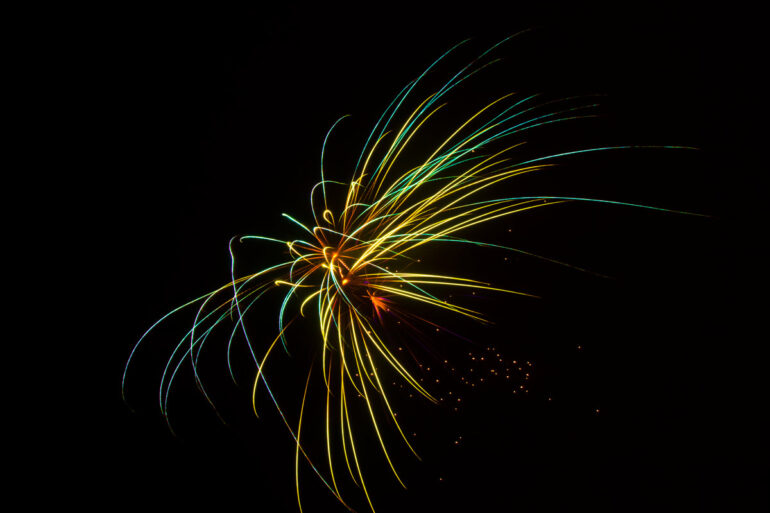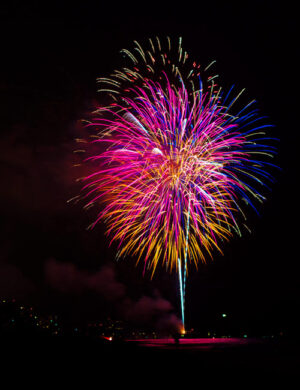We may earn a commission when you purchase through affiliate links. Learn more.
Nothing brings out the cameras in a crowd like a fireworks show! Unfortunately, lots of those people you see taking pictures end up going home with photos of the fireworks that don’t really capture the intensity and beauty of the explosions, but getting some great shots at the next fireworks show isn’t difficult if you spend a little time brushing up on your skills.
1. Bring the right gear
If you want to take frame-worthy shots of the fireworks, you’ll need a few basics.
- A camera that offers manual exposure control to capture long exposure fireworks photography. Any DSLR or mirrorless camera like the Canon T6i, Nikon D3300, and Sony A7 II will all work perfectly, but even some compact cameras like the Sony RX100 IV or Canon PowerShot G1 X Mark II also provide the manual control needed for long exposure photography.
- A tripod is a must-have item for fireworks photography. Since you’ll be shooting long exposures to capture the full explosion of the fireworks, you want to avoid blurry shots by keeping your camera as still as possible. If you don’t already have a tripod, a few high quality, affordable options include the Slik Sprint Pro II, MeFOTO BackPacker Travel Tripod, and Oben AC-1441 4 Section Aluminum Tripod.
- A shutter release cable or remote will make triggering your long exposure shots simple without requiring you to touch your camera, which introduces vibrations that can cause blurry photos. If you’re sticking with exposures of 30 seconds or under and don’t have a cable release or remote, one option you can use is to set a 2 second self-timer on your camera so that by the time the exposure begins, any vibrations caused by pressing the shutter button have subsided.Some cable releases are compatible with several camera models, but you’ll want to verify that your camera will work with the cable release you’re looking at.
What about lenses?
Because you probably won’t be shooting wide open, it’s OK if your lens isn’t the fastest around. A kit lens that is often bundled with cameras like the Canon EF-S 18-55mm f/3.5-5.6 IS II lens or Nikon AF-S DX NIKKOR 18-55mm f/3.5-5.6G VR II will work just fine.
- Focal Length & Maximum Aperture - 18-55mm f/3.5-5.6 II
- Lens Construction - 16 elements in 12 groups, including UD-glass and aspherical lenses
- Diagonal Angle of View - 74 20' - 7 50' (with APS-C image sensors)
- Focus Adjustment - Gear-driven
- Versatile 18 55mm focal length range
- 25 percentage smaller and lighter than its predecessors
- Vibration Reduction technology provides 4.0 stops of blur free handheld shooting
- Optimized for DX format cameras
2. Get there early
The early bird gets the worm, and the early photographer gets the best spot to shoot from. You’ll want to check out the area before dark to make sure you can get a great vantage point and claim your little patch of ground before darkness falls and crowds begin to arrive.
3. Find a good view
If you want your photos to have more than just the sky in them, try to find a good location to set up your tripod that affords you a view that includes interesting foreground or background elements that can be included in your composition.
4. Don’t use your flash
You’re going to see plenty of photographers using their camera’s flash, but just ignore them. Fireworks are huge bursts of bright light, and if there’s one thing that a camera flash is terrible at lighting up, it’s another flash! Using your camera’s flash during the fireworks display is just going to light up the smoke and dust floating around in the air and it will help you burn through your camera battery even quicker than usual.
 5. Skip JPEG & shoot in Raw
5. Skip JPEG & shoot in Raw
There’s nothing wrong with shooting in JPEG if you’re just trying to grab some snapshots for Facebook, but tricky lighting situations like a fireworks show are what RAW excels at! If you find some of your shots to be a bit over or under exposed, having the RAW file to work with will give you some extra latitude to correct the exposure in Adobe Lightroom or Photoshop. Because RAW files take up more space on your memory card, you’ll want to bring a large enough memory card along with you like the 64GB SanDisk Extreme PRO SDXC Memory Card to make sure you don’t run out of room during the show.
- Read Up To 95 MB/s/ Write Up To 90 MB/s
- 4K Ultra HD (3840 x 2160p), 3D, Full HD (1920 x 1080p), Speed Class UHS-3
- Compatible with SDXC
- Shockproof, X-Ray proof, and Waterproof
 6. Focus your lens before the show starts
6. Focus your lens before the show starts
You’ll want to make sure autofocus is turned off and set the focus manually before the show starts. You don’t want to find your lens searching for a focus point after each shot, so having the focus locked in place from the start makes it simple to get nice, in focus shots. Be sure to review your first few shots to make sure that everything is in focus and looks the way it should.
7. Start with these settings (but don’t be afraid to change things up)
ISO
With any kind of night-time photography, you almost always want to use the lowest ISO you can to avoid excessive noise in your shots. With most cameras, you’ll find that the base ISO is 100 or 200.
Aperture
Changing the aperture affects the size of your lens’s iris, modifying how much light gets to the camera sensor. A bigger aperture like f/2.8 lets in a lot of light, and a small aperture like f/16 lets in a much tinier amount of light. Start with an aperture of about f/5.6 and increase it to f/8 or f/16 if you find your shots are overexposed.
Shutter Speed
Your exposure time is really going to depend on a few things — how close you are to the fireworks, how big and bright they are, and what your aperture is. You want to try and capture the full burst of the firework explosion, from the rocket streaking into the sky, to the full, flowerlike path of the light trails as they spread outward. A shutter speed of between 2 to 4 seconds is a great starting point, but if you want to capture even more fireworks explosions in your shot, you can certainly increase the exposure time. Just be aware that the longer you leave your shutter open for, the easier it will be to overexpose your shot — you’ll need to compensate for longer exposure times with a smaller aperture or even by using a neutral density filter like the Tiffen 0.3 Neutral Density filter which reduces the light reaching your sensor by 1 full aperture stop.
Trying out various exposure times is a great way to keep your photos from the fireworks show looking fresh and varied. It’s easy to find an exposure setting that works and stick to it, but once you’ve got a handful of amazing shots, feel free to try your hand at other settings.
8. Bring extra batteries
Shooting long exposures can definitely soak up battery life, especially if your main camera battery is older and doesn’t hold a charge for as long as it originally did. Bringing along an extra battery or two is a good plan so that if your camera battery suddenly dies on you, you can pop in a new battery and continue shooting.
9. Avoid overexposure by reviewing the histogram
You can usually display your camera’s histogram feature by pressing the Info button while you’re reviewing a photo.
The histogram displays a digital photo’s tonal range from dark black shadows on the left of the graph to bright white highlights on the right of the graph. When you see a high spike, that tells you that a large portion of your photo has pixels of that tone — the more pixels in your shot that have that tone, the higher the spike will go. With fireworks photography at night, you should expect to see much of the tonal information on the left side of the histogram since the surroundings will be dark, but the brighter highlights from the bursts and explosions will spike on the right half of the histogram — what you want to steer clear of is a sharp spike pressed directly against the right side of the graph which indicates blown highlights with detail that likely can’t be recovered.
If you see a big spike at the far right of your photo of the fireworks, it can indicate that you’ve allowed too much light to reach the sensor and instead of the bright colors of the fireworks, you’ll just have overexposed white streaks of light. You can correct this by either reducing your ISO, decreasing your exposure time, or increasing your F-Stop to allow less light through the lens’s aperture.
10. Deal with any Long Exposure noise later
Many DSLR & mirrorless cameras can utilize long exposure noise reduction, a setting that takes one regular shot and then a second shot of the same time with the shutter closed, using a method called dark frame subtraction to remove the digital noise caused by the camera sensor heating up from the first shot. This technology and the ability to map the sensor noise is really neat, but because it doubles the time needed for every shot, many photographers prefer not to enable it during situations like fireworks. Post processing software like Photoshop and Lightroom in the Adobe Creative Cloud Photography Plan does an excellent job of reducing noise from your images.
11. Don’t forget to enjoy the show!
It’s easy to get caught up in the process of taking photos, but don’t neglect the opportunity to actually look up from the camera and savor those fireworks with your own eyes!




 5. Skip JPEG & shoot in Raw
5. Skip JPEG & shoot in Raw
 6. Focus your lens before the show starts
6. Focus your lens before the show starts